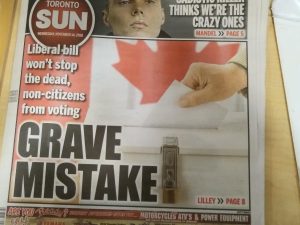I believe the third time anyone writes an article on the same creepy topic, it is time either to cease and desist, or to make this into an ongoing series, embracing the concept whole.
Twice before, I have written with a straight face about how the dead participate in all parts of the electoral process, being both the voters, and those being voted on. And I have written more than once, that dead people have often won elections against their living opponents. While all this sounds both creepy and hilarious, these stories are utterly true. And before you think this is a liberal or conservative conspiracy, I also reiterate, that the dead benefit both sides of American politics. Since there are more dead people than living, we call them the real Silent Majority in this blog. We ought to root for them, since many of these are hard-working dead people who have never committed crimes, and don’t bother anyone.

Just yesterday in The Toronto Sun, the front page — yes, the front page, in the biggest screaming headlines you have ever seen in your life, decried the Liberal practice of leaving dead people on the voter rolls. So, now the silent majority have invaded the Canadian Liberal party, according to The Sun. While I understand that the Sun takes every opportunity to attack the Liberals, and have never met a politician to the right of Atilla the Hun they didn’t like, I have to say, the dead are not a voting block. I am certain that the list contains conservatives and liberals in fairly equal numbers. Regardless, no one can control the voting preferences of the Silent Majority, since you can’t speak to them, and they can’t speak to you. Even if you could speak to them, the Silent Majority will just vote as they damn well please. Or, do anything else they damn well please. You may have your perceptions and illusions about the Silent Majority, but we can both agree that you can’t tell them who to vote for. They just won’t listen, and you can’t change that.
You can call me a leading authority on the voting behavior of the Silent Majority. I have been observing them for quite a while now. And a good many years from now, I too will some day go to the Majority. To be honest, it’s pretty boring watching them, because I never see them move. I guess that’s part of their mystique.
Visits: 111
